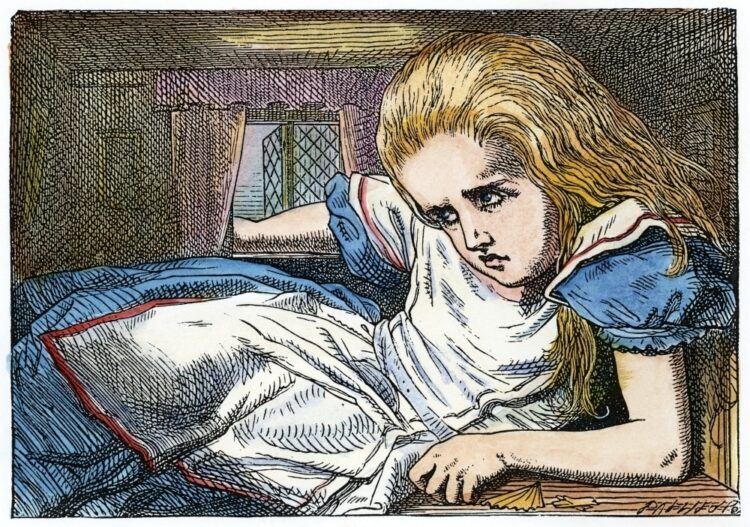
What is Alice in Wonderland Syndrome?
Today we’re looking at another rare medical condition called Todd’s syndrome AKA Alice in Wonderland syndrome (AIWS). And if you know anything about the books or movies (specifically the food parts), you can probably guess what this disorder might do to people’s minds.
Let’s take a closer look at this unusual yet fascinating condition.
What is AIWS?
It’s a neuropsychological condition that causes people to see and feel things (or themselves) as out of proportion to objects around them. Their perception of objects can be distorted to appear…
- Smaller than what they really are. This is called “micropsia”
- Bigger than what they are. Also called “macropsia”
- Closer than their actual position. Another name is “pelopsia”
- Farther away than the real position. Also called “teleopsia”
However, distortions aren’t only for what people see. Other senses can be affected too. This includes time, hearing, touch, etc. There can also be hallucinations. People might feel that parts of the body are growing, shrinking, or distorting right before the person’s eyes. In medical terms, this is called…
- microsomatognosia (shrinking)
- macrosomatognosia (growing)
The Discovery of Alice in Wonderland Syndrome
It was John Todd, a British consultant psychiatrist at High Royds Hospital in West Yorkshire, that first noticed something strange with his patients.
Whenever they experienced headaches, they would also experience object distortion. However, none of them had brain tumors, sight problems, or any mental illnesses that would explain the strange condition. They were also very aware that what they were seeing was incorrect.
The interesting thing is Lewis Carroll’s (author of Alice in Wonderland) diary has notes of him visiting a prominent ophthalmologist. He had been suffering from migraines that resulted in visual distortions for years. He called them “bilious headaches” that came with feeling sick and vomiting. Obviously, this was the inspiration for the “Drink Me” and “Eat Me” parts of Carroll’s books.
It’s also why Todd named the condition Alice in Wonderland Syndrome.
Causes & Symptoms of AIWS
This syndrome actually comes with over 60 symptoms – mostly because it can affect sight, touch, hearing, and sensations (as well as body perception). The most common symptoms are headaches, migraines, nausea, dizziness, and agitation.
However, some lesser common ones can include loss of coordination or limb control, memory loss, emotional instability, fever, epileptic seizures, as well as lingering touch and sound sensations.
Since AIWS is fairly rare, the causes are still a bit of a mystery. But a 2016 study narrowed the key causes down to migraines and Epstein-Barr virus infections. Other causes can include…
- Brain lesions
- Epilepsy
- Influenza a virus
- Lyme neuroborreliosis
- Medication
- Mycoplasma
- Psychiatric conditions
- Scarlet fever and tonsillopharyngitis
- Stroke
- Typhoid encephalopathy
- Varicella-zoster virus
Diagnosis & Treatment of Alice In Wonderland Syndrome
It shouldn’t come as a surprise that there’s no formal list of tests to know if someone has AIWS, mostly because the symptoms and causes are so wide. Generally, a patient could expect…
- Electroencephalography (EEG)
- MRI scans
- Neurological and psychiatric consultation
- Routine blood testing
Even if there is no official test procedure, doctors still need to be thorough because the only way to treat AIWS is to know the underlying cause. So, if migraines are the source, the doctor would prescribe medication and lifestyle changes. But if the reason came from epilepsy, then someone would need antiepileptics. The same goes for infections (which need antiviral medication).
However, it can also end up being a condition that can be commonly misdiagnosed.
Also, even if someone only experiences this phenomenon once and for a short period of time, they should still see a doctor.
Other Interesting Facts
- AIWS is not hereditary. You can’t pass it on to your children.
- Most cases are considered benign.
- It’s more frequently seen in children and young adults.
- The condition is diagnosed in the season 8 episode Risky Business.
- The average age of the start of Alice in Wonderland syndrome is six years old.
- Micropsia has also been related to Jonathan Swift’s novel Gulliver’s Travels.
- Some people suggest that Carroll knew about distorted perceptions through his knowledge of hallucinogenic mushrooms.
Final AIWS Thoughts
This condition can seem rather scary, especially to young children who experience it. But with the right doctor, proper testing, and correct treatment (as well as plenty of reassurance that everything is okay), it’s very manageable, even curable.














